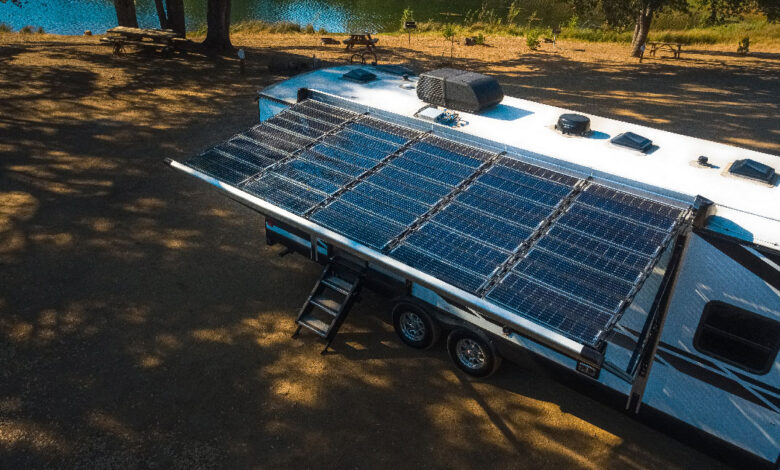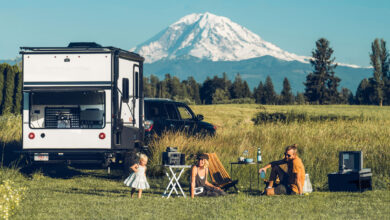Innovative Power Solutions Drive Efficiency & Sustainability in the RV Industry
New advancements in high-voltage systems, smart charging and solar technology are enhancing power efficiency and off-grid capabilities for RV manufacturers and suppliers.

Editor’s Note: This is Part 1 of the four-part “Powering the Future: Insight on RV Energy Solutions.” For the main page with links to all four parts, click here.
What’s new & innovative in power solutions for the RV industry?

Eric Meadows, Lithionics, president: The most exciting innovations revolve around the higher voltage applications. More electrical components are being launched at 48-volt versus the traditional 12-volt components. For instance, Lithionics launched a 48-volt Smart Alternator that can produce almost 7,000 watts, which can charge one of our 8.4kWh batteries from zero to fully charged in about 75 minutes. You are also seeing 48-volt air conditioning and other appliances that offer fantastic efficiencies with a 48-volt battery system. Efficiency in our world equates to more power for longer, which provides game-changing experiences.

Mike Kurtz, REDARC Electronics, North American OEM sales leader: Innovation is being driven by a demand for more integrated, efficient and intelligent power solutions. The Redworks QuickFit Power Panels redefine installation efficiency with prewired, compact units that consolidate key components into a single, Australian-made solution. Built for OEMs, they can cut installation time by up to 50%, reduce labor and inventory costs, and support advanced features like mood lighting through RedVision compatibility. Meanwhile, the BCDC Alpha stands out as [one of] the only DC-DC chargers capable of both charging and recovering start batteries using solar power, with real-time monitoring via the RedVision app and the Green Power Priority system that reduces alternator load. Finally, the Manager Alpha delivers charging power from AC, DC and solar simultaneously, up to 100 amps, while remaining 55% smaller and 28% lighter than comparable setups. Its Bluetooth 5.1 connectivity, intelligent battery management and extreme durability make it ideal for modern, high-powered RV builds.
EcoFlow Technology Inc.: The RV industry is experiencing a wave of innovation in power solutions, driven by the growing demand for off-grid capability, enhanced energy efficiency and eco-conscious travel. At EcoFlow, we’re proud to be at the forefront … with our On-the-Road Power Solutions — a suite of user-friendly products designed to make life on the road feel just like home. Our latest 5kVA 48-volt Power Kit is [one of] the world’s first compact modular power systems for RVs and tiny homes. Whether traveling in a Class A, B or C RV, this system gives users the freedom to explore off-grid without sacrificing comfort. It supports both AC and DC output, offers expandable capacity up to 45kWh and can power essentials like fridges, lights and air conditioning for over a week. It also recharges fast — up to 12kWh in one hour — via solar, shore power, vehicle alternator or generator. Complementing the Power Kit is the 800-watt Alternator Charger, a compact, 3-in-1 device that fast-charges while driving, maintains battery health and jump-starts vehicles, all while integrating with EcoFlow’s portable stations and panels. We also just launched the Wave 3, a portable air conditioner and heater, and the Glacier Classic, a 3-in-1 portable electric cooler, freezer and battery solution designed to enhance camping and RV life. The Wave 3 delivers improvements in cooling and heating capacity, smart control functions, energy efficiency and water drainage. The Glacier Classic comes in three sizes — 35L, 45L and 55L — and has a compact battery system seamlessly integrated into its insulation, enhancing cooling performance while maximizing storage capacity.

Andrew Stiebler, RVMP, GM of aftermarket sales & marketing: We’re seeing a shift toward smarter, more adaptable solutions — things like EFI-equipped generators that optimize fuel use, ultraquiet inverters with clean power output for sensitive electronics and integrated solar-hybrid systems that extend off-grid capabilities. The real innovation lies in flexibility: giving RVers the ability to seamlessly switch between power sources, monitor usage via connected apps and reduce emissions without compromising performance. It’s not just about more power — it’s about better, cleaner and more user-friendly power.

Ellen Lee, BLUETTI POWER Inc., PR specialist: As we’ve deepened our understanding of RV life — especially the needs of those who spend extended periods off-grid — we recognized an urgent need for a more powerful, flexible and space-efficient solution. That’s why we’re proud to introduce the Apex 300 Versatile Power Station. This product is more than just a power upgrade. It’s our response to the real, recurring challenges faced by RVers — from space constraints and power demands to mobility, versatility and energy resilience.
-
- Space Efficiency & Power-to-Size Ratio — Nearly 70% of RVers cite limited space as a major concern. They care not only about total battery capacity but also whether that capacity is worth the space it consumes. High energy density — more power with less bulk — is a major value indicator. That’s why Apex 300 was designed with maximum power in minimum volume. With 2,764.8Wh capacity and up to 3,840-watt output, it delivers robust performance in a [compact] footprint. In fact, it offers 40% higher energy density than others in its class, meaning more energy, less bulk and no wasted space.
- High Output Capacity & RV-Specific Outlets — RVers need to power multiple appliances at once, from AC units to microwaves to laptops. The Apex 300 solves this with a 3,840-watt output, enough to cover nearly all onboard needs. It includes dual 120-volt/240-volt AC outlets, four standard AC ports and dedicated NEMA TT-30R and NEMA 14-50R ports, supporting both 30A and 50A rigs — from travel trailers to Class A motorhomes. Pair it with the Hub D1, a clip-on mountable DC power hub offering 700-watt output across seven ports, including a 12V/50A Anderson port for easy, safe DIY setups.
- Ultra-Low 20W AC Idle Drain — Every watt counts off-grid. Low AC idle drain means less waste. BLUETTI has achieved [20 watts] AC idle drain through advanced engineering upgrades. This translates to up to 40% more runtime for connected devices compared to similar products. In real-world terms, that means more than 24 hours of additional fridge runtime, 2.5 times longer AC standby time or 2.5 extra days of CPAP usage.
- RV-Friendly Charging Ports — Most RV owners look for specific ports like NEMA TT-30R to directly recharge their vehicles. These ports make it possible to stay off-grid longer without needing to rely on campground hookups. The Apex 300 includes both NEMA TT-30R and NEMA 14-50R ports, allowing direct RV recharging without adapters. It’s compatible with virtually all RVs from most popular travel trailers to Class A motorhomes, and lets users stay off-grid longer, without relying on campground hookups.
- Multiscenario Compatibility — Data shows a strong overlap between RV travel and emergency home backup as the two most common scenarios where users rely on portable power stations. After all, people aren’t always on the road, and power outages don’t happen every day. So why invest in separate systems for each? … The Apex 300 is a single, smart energy solution designed to deliver maximum value across multiple use cases — from weekend boondocking trips to unexpected blackouts at home. [It also demonstrates] BLUETTI’s commitment to ESG: building sustainable products that reduce waste, promote resource efficiency and serve users across every aspect of their lives. The hot-swappable battery design enables an unplug-and-go experience, offering flexibility without disrupting home power systems. Paired with a compact form factor and foldable trolley, the Apex 300 is built for effortless mobility — whether users are transitioning between indoor and outdoor setups or relocating their off-grid base.
- Built to Last — Based on the proven performance of the Elite 200 V2, the Apex 300 uses second-gen, automotive-grade LiFePO4 cells engineered for up to 17 years of use. Whether parked under a scorching sun or powering through a storm, it delivers stable, dependable power again and again.
- Silent Operation: As Quiet as 40dB — Noise is a major concern for RVers. A loud generator can spoil the peace of camping and even create tension with fellow campers. Quiet systems greatly enhance the overall user experience. The Apex 300 runs as quietly as 40dB — about the volume of a gentle rain — making it ideal for use around kids, pets, seniors or during nighttime hours.
- Fastest Payback in Two Years — For some RVers who own an off-grid cabin or have a household rooftop solar setup, Apex 300 can be paired with the SolarX 4K — a 500-volt/4,000-watt PV voltage regulator designed for portable power stations — the system pays for itself in just two years. This ensures long-term savings for those powering off-grid cabins or integrating solar into their homes.
- Fast Charging — When you’re preparing for a blackout or your next leg of the journey, speed is essential. With up to 2,400-watt solar input (dual MPPT), it hits 80% in 40 minutes and 100% in just 65 minutes via AC input. [It features] up to 560-watt DC-to-DC charging from your vehicle’s alternator using the Car Charger 1, capturing wasted energy while you drive.
With multiple recharging options and record-fast turnaround, Apex 300 is always ready when you are.

Matthew Bondie, Revatek, director of sales: Lithium-ion batteries are becoming increasingly popular due to their longer lifespan, lighter weight, higher energy density, faster charging times and ability to discharge 100% of their capacity safely. It’s very important that the relationship between the alternator and battery bank is regulated efficiently, ensuring the longest lifespan and best performance from your power system. Revatek’s Altion is [one of] the world’s most advanced alternator regulators. The Altion optimizes your power system, ensuring your batteries charge faster and last longer. The Altion possesses differentiators such as 20%-35% faster charging using excess engine power; universal compatibility works with all major battery chemistries (lead-acid, lithium) and 12-48-volt systems (8.5-60-volt operating range); app-free Wi-Fi connectivity and automatic software updates; and Boost Mode, which harnesses the full power of the alternator to charge the batteries when the Altion senses that the engine has excess power available across the full RPM range. We also offer a premium version of the Altion — the Altion Max — which offers advanced control for up to two alternators and two battery banks. It also features a built-in screen to monitor system status, including state of charge, charge stage, voltage and more. We are striving to deliver … battery charging solutions built for the demands of the off-grid RVing lifestyle.

Rohini Raghunathan, Xponent Power, CEO and founder: Xponent Power’s award-winning and patented Xpanse solar system is [one of] the industry’s first retractable rigid solar panels. Its ultralow footprint fits on only six inches of RV roof corner, enabling installation even when roof space is extremely limited. When open, the 50 solar panels expand to seven feet and can also work as an awning. [It features] double-sided panels that generate 1,200 watts and capture both direct and reflected sunlight while the bypass design means even if one panel is shaded, the other 49 keep working. … When winds pick up, SmartSensors automatically retract the panels into a high-strength aluminum shell to keep them out of harm’s way. … The integrated Xponent Power mobile app [allows users] to remotely operate, monitor and manage real-time power generation and battery status, compare past performance and more. It even has a parking tool to show how the best position for max power.

Daniel Clarkson, Navico Group, VP & GM, Navico Connect: Recent innovations in power solutions for the RV industry are transforming the way users manage their energy needs. … Fathom’s user-friendly graphical user interface (GUI) ensures customer success with intuitive controls — simply push a button and it works. This interface optimizes charge settings for various shore power stations, ensuring efficient energy use. Additionally, Fathom’s advanced load management and shedding techniques help alleviate “range anxiety” by prioritizing essential functions and conserving power. The integrated lithium-ion technology provides reliable, long-lasting power without the noise, vibration or fumes of traditional generators. Proper storage solutions for both short-term and long-term needs further enhance reliability, making RV travel more convenient and stress-free.
Find more answers on this topic on RV PRO’s website at rv-pro.com/tag/2025-powering-the-future/.


